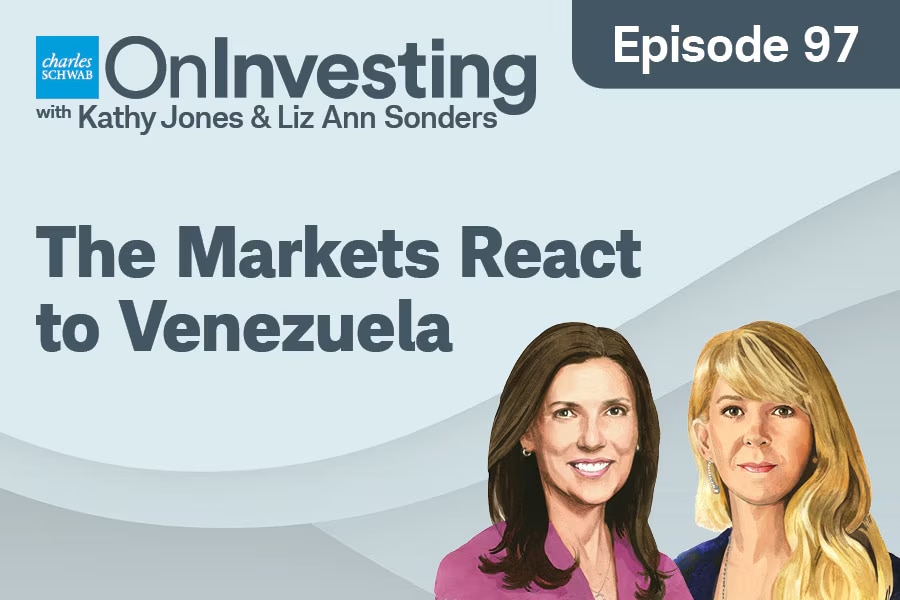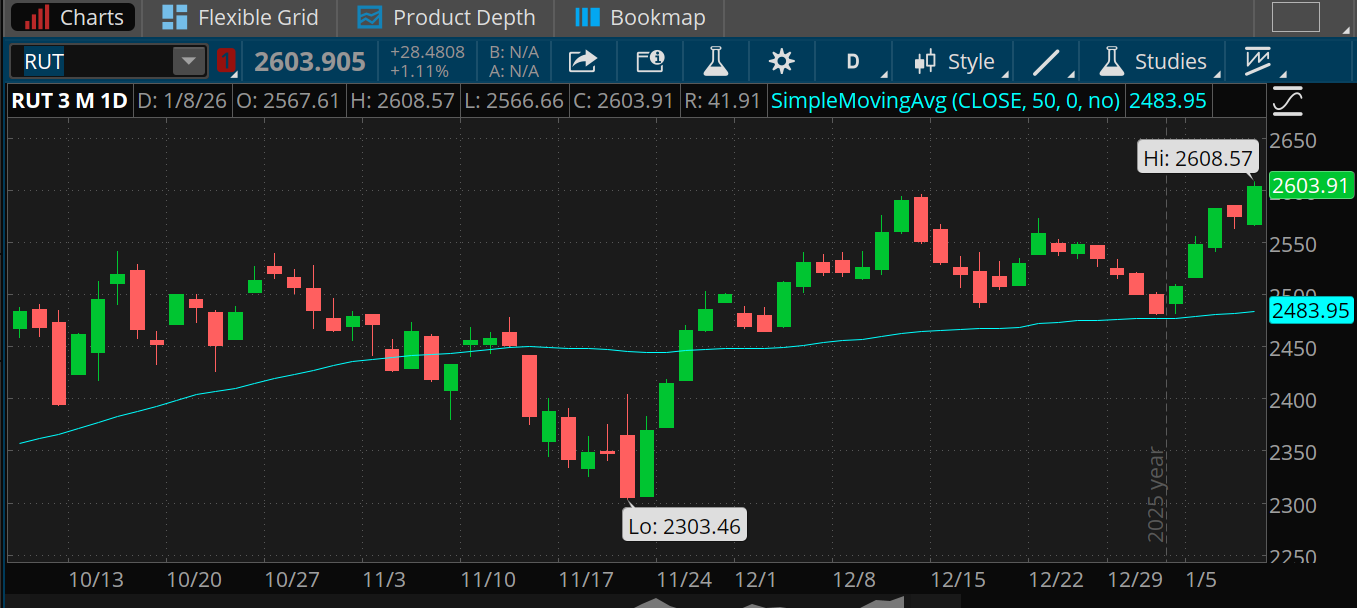Stocks Up as Jobs Report Creates Mixed Picture

Published as of: January 9, 2026, 9:18 a.m. ET
Listen to this article
Listen to this article here or subscribe to the Schwab Market Update podcast in your favorite podcast app.
| The markets | Last price | Change | % change |
|---|---|---|---|
| S&P 500® index | 6,921.46 | +0.53 | +0.01% |
| Dow Jones Industrial Average® | 49,266.11 | +270.03 | +0.55% |
| Nasdaq Composite® | 23,480.02 | –104.26 | –0.44% |
| 10-year Treasury yield | 4.19% | +0.01 | -- |
| U.S. Dollar Index | 98.96 |
+0.03 |
+0.03% |
| Cboe Volatility Index® | 15.16 | –0.29 | –1.88% |
| WTI Crude Oil | $58.11 | +$0.35 | +0.61% |
| Bitcoin | $90,460 | –$566 |
–0.62% |
(Friday market open) The jobs picture stayed lackluster in December as the economy created just 50,000 positions, according to Friday's nonfarm payrolls report. That was down from a downwardly revised 56,000 in November. However, unemployment fell unexpectedly to 4.4% from a revised 4.5% in November, possibly a relief for Federal Reserve officials who'd worried about a recent climb. Analysts had expected jobs growth near 70,000 and unemployment of 4.5%. Major indexes initially rose on the report, perhaps amid thoughts that unemployment dropping means a stronger economy. January rate cut odds dropped sharply.
"The jobs report will likely be welcomed by Fed officials as the unemployment rate, a key indicator they follow, ticked down by two tenths of a percent," said Collin Martin, head of fixed income research and strategy, Schwab Center for Financial Research (SCFR). "Yields initially rose following the release, likely due to the headline-grabbing drop in the unemployment rate, but have since fallen to where they were before the release, as a comprehensive look at the report supports the idea that the labor market is continuing to cool. This shouldn't change the Fed's near-term plans, and we still expect the Fed to hold rates steady for the next few meetings."
Major indexes ended mixed Thursday. The tech sector, dominated by mega-caps, kept the S&P 500 index in check even as advancing shares outpaced declining ones overall. Strength in energy, staples, discretionary, and materials reflected positive economic data, but was balanced by weakness in semiconductors. The Russell 2000 (RUT) index of small caps climbed and so did the Dow Jones Industrial Average, but the Nasdaq retreated.
To get the Schwab Market Update in your inbox every morning, subscribe on Schwab.com.
Three things to watch
- Jobs data deeper dive: Though jobs growth in December wasn't far off expectations—which had risen from around 55,000 to 70,000 over the last few days—revisions to the previous two reports were relatively steep, removing 76,000 positions. October now looks like an extremely weak month with 173,000 jobs lost, though the government shutdown likely had an impact and may also have affected data collection. The three-month average for job losses is now 22,000. December job creation mostly congregated in positions that are less lucrative, like food services, health care, and social assistance. Retail trade lost 25,000 jobs, but federal government employment was little changed. Goods-producing jobs fell 21,000, and manufacturing payrolls fell for the eighth-straight month. Wages climbed 0.3%, in line with expectations, but the average work week fell slightly. Though investors often focus on jobs gained and jobs lost, the main thing in this report is likely the unemployment rate, at least as far as the Fed's concerned. The rise to 4.6% in November—now revised to 4.5%—was concerning, so policy makers will probably be glad to see it come down in December to 4.4%. That's showing up in the CME FedWatch Tool, which now indicates a 5% chance of the Fed cutting rates later this month, down from 15% earlier this week. Treasury yields were steady near the high end of their recent range at 4.19% for the 10-year note soon after the data hit.
- Tariff decision by Supreme Court may be close: As investors digest jobs data, they brace for a possible Supreme Court opinion on President Trump's tariffs. There's no guarantee it will be among rulings the court begins releasing today at 10 a.m. ET, but it's possible. "Based on oral arguments, it is widely believed that the justices will rule against the administration, upending one of the president's signature policies and perhaps triggering a complicated refund process for more than $120 billion in tariffs paid to date," said Michael Townsend, managing director of legislative and regulatory affairs at Schwab. "But the president has other emergency authorities he can use to impose tariffs, so tariffs aren't going away even if the Court rules against the administration." Also, auto, steel, and semiconductor tariffs aren't affected by the case. A ruling against tariffs wouldn't end all tariffs, and Trump may quickly be able to add some back. Still, any replacement tariffs "would be more constrained than the erratic nature implemented under the International Emergency Economic Powers Act (IEEPA) last year," said Michelle Gibley, director of international equity research and strategy, SCFR.
- Lot check shows many new vehicles unsold: Tesla's (TSLA) weaker-than-expected fourth quarter sales announced a week ago could put more pressure on the company to advance with its robotaxi and battery storage businesses, though analysts anticipate vehicle sales to improve this year. In trying to reignite interest in its vehicles, however, Tesla could face challenges beyond simply the expiration of government EV tax credits. For instance, U.S. auto inventories from 2025 and even 2024 are quite heavy, with inventory topping three million vehicles as of November, according to internet automobile publication Carscoops. Though prices remain high even for leftover autos from the last two years, there isn't a lot of discounting going on yet, the report said, with the average listing price at $49,422, up slightly from the end of 2024. The inventory glut extends across many brands, though Stellantis (STLA) is hardest hit. The new 2024 car with the most leftover inventory is the Dodge Hornet plug-in hybrid, as 82.1% of 2024 models remain in dealer lots. Jeep Grand Cherokee isn't far behind, while General Motors (GM) still has 31% of its 2024 Chevy Malibus remaining unsold, according to the publication. If the inventory hangover begins to weigh on prices, competition could mount for Tesla and other EV makers.
On the move
General Motors (GM) dropped 2% early today after announcing it would record $7.1 billion in fourth-quarter charges due to a pullback in EV sales and restructuring efforts in China, CNBC reported.
Oklo (OKLO) climbed 17% ahead of the open and Vistra (VST) added 14% after Meta (META) announced it would back nuclear projects with the two companies to power AI data centers.
Housing stocks rose in early trading after President Trump said he wants to have "representatives" purchase $200 billion in mortgage bonds to help make homes more affordable. The White House didn't clarify details. Rocket Companies (RKT), a homeowner services firm, rose 4.6% on the news. Home-flipping firm Opendoor Technologies (OPEN) rose 8%. Home builders Lennar (LEN) and D.R. Horton (DHI) also each gained around 2%.
Intel (INTC) rose 2.5% in early trading after the chip firm received praise from President Trump, who met with the company's CEO. The U.S. government took a stake in Intel last year. Other semiconductor stocks— including Broadcom (AVGO) and Micron (MU)—rose along with Intel, after a tough day for the sector yesterday.
Shares of energy companies including Exxon Mobil (XOM), Chevron (CVX), and Conoco Phillips (COP) climbed Thursday as oil prices rose in response to solid U.S. economic data. The energy sector was mixed this morning. Constellation Energy (CEG) climbed 5% ahead of the open after TD Cowen initiated coverage with a buy rating.
Mining and rare earth firms generally rose early today. Bloomberg reported that Rio Tinto and Glencore are in talks to form the world's largest miner. Silver and copper rose 3% and 2%, respectively, in the early going.
Bitcoin (/BTC) slipped about 0.6% this morning, still above $90,000. Tests of the 50-day moving average near $93,000 haven't been successful over the last week. Shares of crypto-related stocks were mixed early.
The S&P 500 index would likely have enjoyed a nice gain Thursday except for softness in well-known tech names including Intel, Micron, Broadcom, Advanced Micro Devices (AMD), Oracle (ORCL), Nvidia (NVDA), Microsoft (MSFT), and Western Digital (WDC). Semiconductors fell nearly 2% Thursday. The widespread selling amid a lack of notable news indicated possible profit taking after a solid start to the year, especially for chips.
The Atlanta Fed's GDPNow forecast for fourth-quarter gross domestic product, or GDP, doubled Thursday to 5.4% based on recent data along with a strong balance of trade report for October, Briefing.com noted. And the New York Fed Survey of Consumer Expectations for December showed year-ahead inflation expectations climbing to 3.4% from 3.2%, though long-term inflation expectations were unchanged.
Strength yesterday in the Russell 2000 (RUT) index of small caps likely reflected positive U.S. data, which could help smaller companies that tend to do more of their business domestically. However, investors should keep in mind that many Russell 2000 stocks are less likely to be profitable and face a large share of debt coming due over the next few years.
University of Michigan preliminary January consumer sentiment is due at 10 a.m. ET. The headline reading is seen staying near recent historic lows of around 53.0, Briefing.com said. That's down from 74.0 a year ago, dented by tariff, job, and affordability concerns.
More insights from Schwab

Drilling down into data: In their new On Investing Podcast, Liz Ann Sonders, chief investment strategist, SCFR, and Kathy Jones, chief fixed income strategist, SCFR, discuss the news out of Venezuela and the latest economic data. In terms of today's jobs report, they note, it's important to examine the "innards" of the data, not just the headlines, for a broader picture of employment health.
" id="body_disclosure--media_disclosure--542896" >Drilling down into data: In their new On Investing Podcast, Liz Ann Sonders, chief investment strategist, SCFR, and Kathy Jones, chief fixed income strategist, SCFR, discuss the news out of Venezuela and the latest economic data. In terms of today's jobs report, they note, it's important to examine the "innards" of the data, not just the headlines, for a broader picture of employment health.
How to safely keep a crypto wallet: Keeping any amount of crypto requires vigilance. There are plenty of ways to lose it. Hardware breaks or gets lost. Exchanges are hacked. While holding crypto comes with these risks, there are plenty of ways to protect a wallet. Learn about them in our latest cryptocurrency article. In our new cryptocurrency video, explore ether, the second-largest cryptocurrency, how it works, and how it differs from bitcoin.
Sector check: Schwab's monthly stock sector outlook was unchanged for January, with communication services, industrials, and health care staying at Outperform, based on generally solid fundamentals and the potential ability of the first two to benefit from artificial intelligence adoption.
Chart of the day

Data source: FTSE Russell. Chart source: thinkorswim® platform.
Past performance is no guarantee of future results.
For illustrative purposes only.
The Russell 2000 (RUT–candlesticks) had a fast start this year, up nearly 5% so far and reaching a new all-time intraday high and close yesterday. The small-cap index is up 13% from the November low and well above its 50-day moving average (blue line) after a quick test and bounce at the end of 2025.
The week ahead
Check out the investors' calendar for a summary of the top economic events and earnings reports on tap this week.
January 12: No major data or earnings expected.
January 13: December Consumer Price Index (CPI), September new home sales, and expected earnings from JPMorgan Chase (JPM), Bank of New York Mellon (BK), and Delta Air Lines (DAL).
January 14: December Producer Price Index (PPI), retail sales, Fed Beige Book, and earnings from Bank of America (BAC), Wells Fargo (WFC), and Citigroup (C).
January 15: Expected earnings from Morgan Stanley (MS), Goldman Sachs (GS), BlackRock (BLK), and First Horizon (FHN).
January 16: December industrial production and expected earnings from PNC Financial (PNC), State Street (STT), M&T Bank (MTB), and Regions Financial (RF).